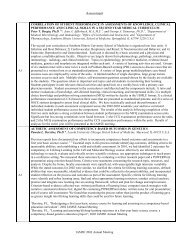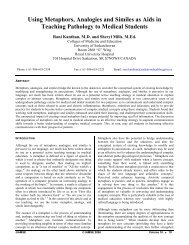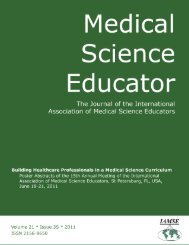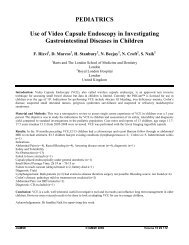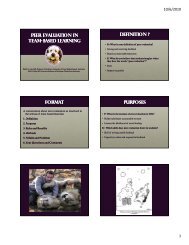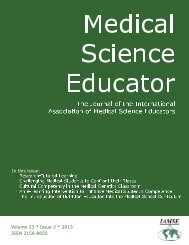Click here to view complete journal in pdf-format - IAMSE
Click here to view complete journal in pdf-format - IAMSE
Click here to view complete journal in pdf-format - IAMSE
Create successful ePaper yourself
Turn your PDF publications into a flip-book with our unique Google optimized e-Paper software.
past decade. The forces driv<strong>in</strong>g this change are<br />
frequently unrelated <strong>to</strong> a desire <strong>to</strong> improve the<br />
ability of students <strong>to</strong> learn this subject matter. T<strong>here</strong><br />
is a need <strong>to</strong> evaluate the impact of these changes on<br />
students’ learn<strong>in</strong>g experiences and outcomes.<br />
results do support the need for further<br />
<strong>in</strong>vestigation. In addition, the f<strong>in</strong>d<strong>in</strong>gs <strong>in</strong>dicate that<br />
labora<strong>to</strong>ry garments worn <strong>in</strong> the ana<strong>to</strong>my<br />
labora<strong>to</strong>ry sett<strong>in</strong>g are not sterile and harbor<br />
potentially pathogenic microorganisms.<br />
Instructional Methods Abstract ID: 186 Award<br />
Nom<strong>in</strong>ee<br />
POTENTIAL PATHOGEN TRANSMISSION<br />
ON MEDICAL STUDENT ANATOMY<br />
LABORATORY CLOTHING<br />
Chandan J. Kabadi, Carroll R. Smith III, Fernando<br />
Gomez M.D., American University of the Caribbean<br />
School of Medic<strong>in</strong>e, Cupecoy, St. Maarten,<br />
Netherland Antilles<br />
PURPOSE<br />
Despite great advances <strong>in</strong> the field of medic<strong>in</strong>e and<br />
sanitation, nosocomial <strong>in</strong>fections rema<strong>in</strong> a very<br />
common and serious issue. Many of these problems<br />
can be avoided by simple hand wash<strong>in</strong>g; however,<br />
other modes of spread<strong>in</strong>g pathogenic microbes are<br />
possible. We set forth <strong>to</strong> determ<strong>in</strong>e if the sett<strong>in</strong>g of<br />
an open cadaver labora<strong>to</strong>ry was conducive <strong>to</strong><br />
transmission of pathogens such as S. aureus, S.<br />
pyogenes, and E. faecalis.<br />
METHODS<br />
Participat<strong>in</strong>g students were asked <strong>to</strong> wear their<br />
labora<strong>to</strong>ry coats at all times <strong>in</strong> the ana<strong>to</strong>my<br />
labora<strong>to</strong>ry and launder accord<strong>in</strong>g <strong>to</strong> their normal<br />
schedule. Culture samples from the sleeves and<br />
front of the labora<strong>to</strong>ry coats were obta<strong>in</strong>ed us<strong>in</strong>g<br />
sterile swabs concentrat<strong>in</strong>g on the participant’s<br />
dom<strong>in</strong>ant side. Sample were collected before any<br />
engagement between the students and cadavers,<br />
and after the gastro<strong>in</strong>test<strong>in</strong>al tract was explored.<br />
The samples were then <strong>in</strong>oculated and cultured, and<br />
microorganisms were isolated on specific growth<br />
agars.<br />
RESULTS<br />
In the <strong>in</strong>itial sampl<strong>in</strong>g, which was done before<br />
students had cadaver contact, S. aureus was found<br />
on the garments of 13 of the 67 students, 5 students<br />
had S. pyogenes, and none had E. faecalis on their<br />
labora<strong>to</strong>ry coats. In the lab coat sampl<strong>in</strong>g done after<br />
the gastro<strong>in</strong>test<strong>in</strong>al tract was exposed, 19 students<br />
of the 67 students were found <strong>to</strong> have S. aureus, 8<br />
had S. pyogenes, and 4 had E. faecalis on their<br />
labora<strong>to</strong>ry coats.<br />
CONCLUSIONS<br />
While it hard <strong>to</strong> attribute a specific source of<br />
transmission of S. aureus, S. pyogenes and E.<br />
faecalis <strong>to</strong> labora<strong>to</strong>ry cloth<strong>in</strong>g from this study, the<br />
Instructional Methods Abstract ID: 187<br />
DEFENSE AGAINST INTRACELLULAR<br />
MICROBES-ASSEMBLING THE BIG<br />
PICTURE TOWARDS COMPETENCY IN<br />
IMMUNOLOGY<br />
Janet F. Piskurich, Department of Medical<br />
Education, Texas Tech University Health Sciences<br />
Center, Paul L. Foster School of Medic<strong>in</strong>e, El Paso,<br />
TX, USA<br />
PURPOSE<br />
The 2009 Scientific Foundations for Future<br />
Physicians Report of the AAMC-HHMI Committee<br />
recommends competencies that all medical students<br />
should demonstrate. An associated learn<strong>in</strong>g<br />
objective for competency M4, most related <strong>to</strong><br />
immunology, states that students should be able <strong>to</strong><br />
“Apply knowledge of the mechanisms utilized <strong>to</strong><br />
defend aga<strong>in</strong>st <strong>in</strong>tracellular or extracellular<br />
microbes <strong>to</strong> the development of immunological<br />
prevention or treatment”. Yet medical students<br />
express frustration that they cannot assemble a<br />
comprehensive big picture for how the immune<br />
system builds an immune response aga<strong>in</strong>st a<br />
microbe.<br />
METHODS<br />
A “big picture” diagram of an immune response<br />
aga<strong>in</strong>st an <strong>in</strong>tracellular microbe was prepared. As<br />
relevant parts were covered, students were given<br />
relevant sections of the diagram. Upon completion,<br />
students were provided with the entire diagram<br />
<strong>in</strong>clud<strong>in</strong>g numbered steps and explanations for each<br />
step.<br />
RESULTS<br />
While we feared the <strong>complete</strong> diagram might<br />
<strong>in</strong>itially overwhelm the students, their responses<br />
<strong>in</strong>dicated that they would prefer hav<strong>in</strong>g the entire<br />
diagram upfront so that they might have it as an<br />
advance organizer for their study. They regarded the<br />
diagram as a valuable learn<strong>in</strong>g <strong>to</strong>ol.<br />
CONCLUSIONS<br />
To fulfill the objectives recommended by the 2009<br />
AAMC-HHMI Committee Report, students must<br />
first understand the big picture of how the immune<br />
system provides defense aga<strong>in</strong>st microbes.<br />
Provid<strong>in</strong>g a “big picture” diagram facilitated<br />
student’s ability <strong>to</strong> understand defense mechanisms<br />
Medical Science Educa<strong>to</strong>r © <strong>IAMSE</strong> 2012 Volume 22(4S) 311



